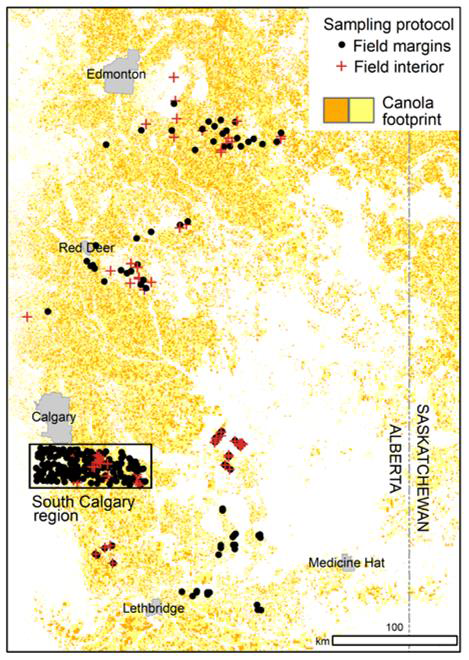Key Result
Non-crop areas within or near to fields can serve as a source and a destination for beneficial insects at different times of the season. A correlational study of 60 million seeded acres of yield data obtained from Agricultural Financial Services Corporation (AFSC) showed that counties in Alberta where fields tend to contain more non-crop areas also have slightly higher canola yields.
Project Summary
Overview
Natural habitats and uncultivated areas (“non-crop areas”) within or near fields may harbour reservoirs of beneficial arthropods that provide services such as pest control and pollination to canola crops. The principal objective of the Beneficial Insects Surveillance Network was to investigate these reservoirs by characterizing the abundance and diversity of beneficial species, and by conducting an initial assessment into the contribution to canola yield of beneficial species that are found in these reservoirs.
After surveying sites in and near cultivated cropland for beneficial insect diversity and abundance the research team used farmer yield data, remote sensing, Agriculture and Agri-Food Canada (AAFC) crop inventory data, and in-person assessments to determine the amount of natural and semi-natural areas in and around annual cropland. With this information, the researchers could determine suitability of variously diverse croplands for beneficial insect habitat, and determine if these spaces contribute to or detract from crop yield.
Results
Beneficial arthropods (wild bees, spiders, ground beetles, and harvestmen) were sampled at 317 sites across central and southern Alberta between 2016 and 2018 (see map), with traps deployed between 500 and 8000 hours at any given site. Trapping locations included field margins and the interior of canola fields positioned at multiple distances from field and wetland margins. A total of 157,407 arthropods of 418 species were identified from these samples and are curated in the University of Calgary Invertebrate Collection. This sampling has generated what is likely to be the most geographically-extensive database on the distribution, abundance, and diversity of beneficial arthropods found in Canadian Prairie croplands.
More specifically, 375 species of wild/native bees were identified in or near fields, many of which are very rare. Fifteen species were at over half the sites, indicating a core group of canola-friendly bees. The researchers also found dozens of rare species of spider in and near crops, and identified 57 species of ground beetle in and near cropland. Study locations that had smaller patches of non-crop area that were more evenly distributed had higher abundances of many bee species.
Analyses of network data show that non-crop areas such as wetland margins, field margins and pivot corners are reservoirs that serve as a source as well as a destination for beneficial arthropods at different times of the season (Robinson et al, submitted for publication). Wetland margins, in particular, may be hotspots for beneficial arthropods, and these organisms spill over into canola fields. A study published by the network (Vickruck et al, 2019), for example, showed that nearly twice as many wild bees were collected at wetland margins than at traps located at a distance of 75 metres into canola fields, and demonstrating that the spill-over declines as the distance from the non-crop area increases.
Finally, the network collected evidence that beneficial arthropods found in non-crop areas do provide services to canola growers such as pest control and pollination. A correlational study of 60 million seeded acres of yield data in Alberta (2012 to 2017), conducted by the network, showed that counties in Alberta where fields have more non-crop areas also have slightly higher canola yields (Galpern et al, 2020). This provides preliminary and indirect evidence that non-crop areas can influence canola yield. A pilot study of five fields, that used cages to exclude arthropods from canola plants, also showed that the spill-over of arthropods from non-crop areas may increase canola seed weight. This result is being confirmed with additional field experiments in the second phase of the network.
Conclusions
Non-crop areas within or near to fields are likely to serve as a source as well as a destination for beneficial arthropods at different times of the season.
As for the yield benefit, a correlational study of 60 million seeded acres of yield data in Alberta obtained from Agricultural Financial Services Corporation (AFSC) showed that counties in Alberta where fields tend to contain more non-crop areas also have slightly higher canola yields. One reason could be that non-crop areas often serve as hotspots for beneficial arthropods that spill over into canola fields, increasing the visitations to canola flowers. This evidence is in line with global literature that proximity to natural and semi natural spaces has a positive effect on the yield potential of cropland, at a landscape scale.
Related Research
A second phase of this project ‘Surveillance Networks for Beneficial Insects II: quantifying the canola yield effect of wetlands, shelterbelts and other insect reservoir habitats‘ which began in 2019, combines field experiments, the beneficial arthropod database, and precision agricultural data to further investigate the relationship between non-crop areas, arthropods and canola yield. Research at the sites across central and southern Alberta will focus on measuring yield and quality parameters of crop grown in proximity to these spaces. Read more about its progress here.






